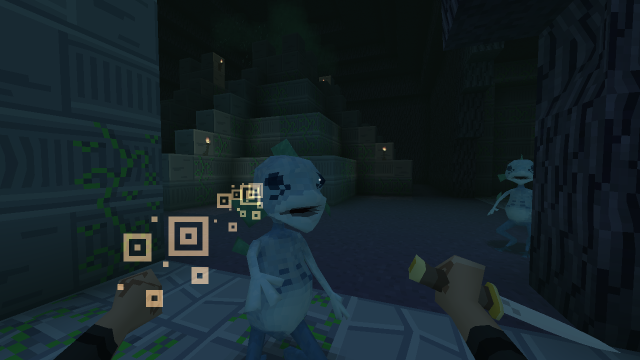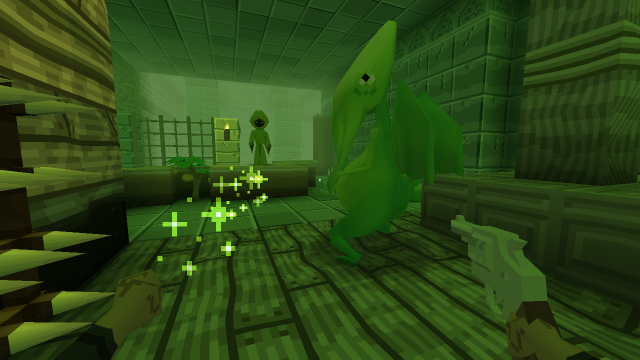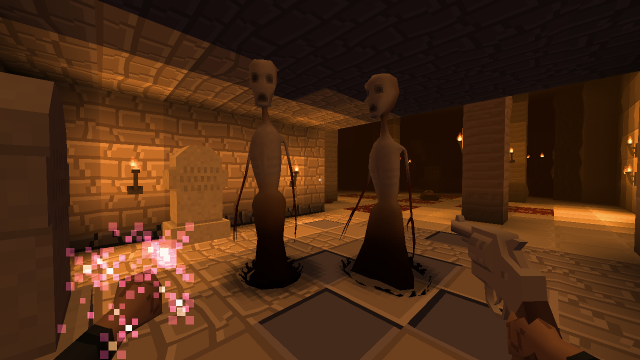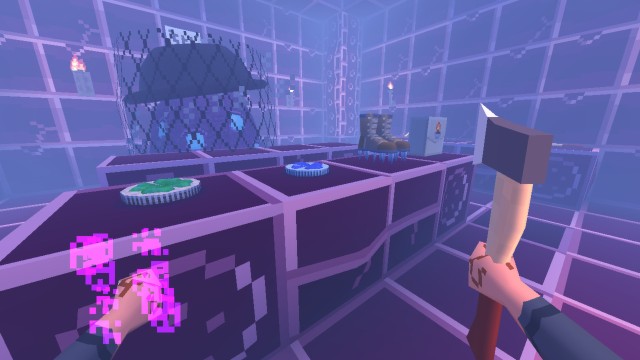I picked up Eldritch on sale a few years ago. I was initially put off by its Minecraft-esque graphics, but Lovecraftian overtones and the promise of an engaging roguelike (or rogue-lite, if you’re a snob about these things) were enough to make me open my wallet – and I’ve got to say, I’m glad I did, because Eldritch is an underappreciated gem.
The goal of Eldritch is simple, in theory: get to the bottom floor of a dungeon, and retrieve the magical macguffin. It’s a setup reminiscent of early roguelikes, such as Nethack or even it’s eponymous predecessor, Rogue. This, however, is where most similarities between Eldritch and other roguelikes end.
Eldritch is a game about fast movement, and mastery of 3D space. The control scheme is more reminiscent of 2016’s Doom than Minecraft, and sees the player hurtling over obstacles, crouch-sliding under barricades, and dashing frantically from all sorts of bizarre creatures. It’s a sheer thrill to simply be running around and dodging out of enemies’ attacks like some sort of Victorian era parkour expert. Players can only jump one bock high, but can pull themselves up and over a 2 block wall fluidly by holding the jump button down.

With so many movement mechanics in play, an experienced player begins to worry less about surviving a run and more about finding the most efficient path to the next part of the dungeon. There is a major hurdle to be overcome with that outlook, however, and that is the randomized nature of each run. No two dungeon layouts are alike, but this is where the game uses its Minecraft visuals to its advantage.
Eldritch uses its Minecraft-esque visuals to provide the player with easily-understood signposting to help the player master movement.
Because every wall, floor, and ceiling of the game is constructed with large blocks, players can easily gauge height and distance at a quick glance. In less than a second, an experienced player can look at a building in the distance and figure out the fastest way to scale it, or can look down a pit and know with certainty where they can and cannot land if they want to avoid fall damage. Eldritch uses its Minecraft-esque visuals to provide the player with easily-understood signposting to help them master movement.
In addition to the movement mechanics intrinsic to the player’s own skill, there are power ups and items that further enhance the player’s ability to run around the dungeons and escape enemies. A magic power gained at a shrine might allow the player to create blocks on the ground or jump higher, and a magic amulet might allow them to destroy pre-existing blocks by expending valuable ammunition. If you play stealthily, there are power ups that help you run silently, or distract enemies – the game gives players loads of options on how they approach any given scenario.

It would be erroneous to assume that the inclusion of all these mechanics make for an easy game. Eldritch is, in fact, a rather grueling experience for new players. Cautious play rules the day, even for experienced players who know what to expect from each stage. Tripwires, bombs, and silently-moving enemies can easily rip an unwary player’s run to shreds in mere moments. I have to give special mention here to the enemies that activate only when the player has line-of-sight with them, and only attack when the player looks away from them, a bit like the infamous “Weeping Angels” of Doctor Who fame.
… these instances test the player’s knowledge of movement mechanics to their limit.
On the flipside of that coin is the Shoggoth, a monstrous entity that cannot be killed, kills in one or two hits, and sprints towards the player almost as fast as they can run. Because you might bump into these nasty enemies at any time in a dungeon with a randomized layout, these instances test the player’s knowledge of movement mechanics to their limit. When these guys show up, you either run away as fast as you can, or you die. No in-between.

The game is not a masterpiece, by any stretch of the imagination. Character designs are amateur at best, but the game gets a bit of a pass since it already looks about as basic as three dimensions get. The “Worm” enemy, which is supposed to attract the attention of other denizens of the deep by screeching when it sees you, is almost never within range of any other monsters, making its sole character trait utterly meaningless. Later levels don’t so much ramp up the challenge as put the difficulty setting on a roller coaster of ups and downs, and enemy AI could use a bit of tweaking to make them more of a challenge to overcome, rather than an obstacle to run around.
That being said, Eldritch gets a very hearty recommendation from me. It’s spooky, it’s heart-pounding, it’s fast, and more than any other deciding factor, it’s fun. It’s the only Minecraft knockoff game I’ve ever seen that has merit, and uses the visual style to its advantage in an original way, rather than simply copying the aesthetics and mechanics of the original. I’ve thrown myself against these dungeons for hours, over and over, and I still have a blast every time I boot it up. I recommend everyone with a few bucks in their Steam wallet to give this game a chance. It may be a rough diamond, but it’s a diamond nonetheless.
Written by UWBW
Edited by Trogdorbad

Powered by WPeMatico